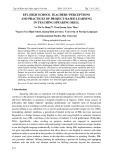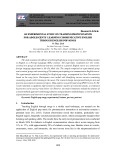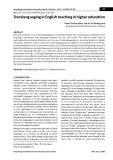
Tuyển tập Hội nghị Khoa học thường niên năm 2024. ISBN: 978-604-82-8175-5
580
DIFFERENTIATED INSTRUCTION AS A TEACHING
APPROACH FOR MIXED-ABILITY EFL CLASSES AT
VIETNAMESE UNIVERSITIES
Le Thi Thanh Hue
Thuyloi University, email: lethanhhue@tlu.edu.vn
1. INTRODUCTION
Over the past several decades, English has
consistently developed to become the most
prominent foreign language in Vietnam.
Under the pressure of social and labour
market requirements, English is a
compulsory subject in almost all curricula in
both public and private universities. One
typical difficulty faced by EFL lecturers at
Vietnamese universities is the student’s
mixed levels of English proficiency in a
single class (Nguyen, 2017). This is
particularly true for non-English-major
students, most of whom have to attend
certain compulsory English classes regardless
of their backgrounds and command of the
language. It is quite obvious how the mixed-
ability in EFL classes hinders the teaching
and learning process as the ubiquitous
traditional “one-size-fits-all” approach tends
to deepen the gaps between stronger and
weaker students and demotivate them in
acquiring language knowledge and skills
(Suwastini et al., 2021). While several
teaching methods have been recommended
and applied by EFL teachers to deal with the
problem in Vietnam, including cooperative
learning techniques (Nguyen, 2017), few
have adopted differentiated instruction (DI)
which is also suggested by researchers and
educators around the world for mixed-ability
EFL classes (Suwastini et al., 2021).
This paper aims to find out what DI is and
explore its benefits and challenges as a
teaching approach for mix-level EFL
classrooms, and thereby discussing its
prospective application in the context of
Vietnamese universities.
2. METHODOLOGY
This study is a secondary research, in
which the writer reviews a number of relevant
research papers and summarizes the main
findings to answer the research questions.
3. FINDINGS
3.1. Definition of DI
By definition, differentiated instruction is
a teaching approach in which teachers vary
what and how they teach to meet their
students’ individual learning needs
(Tomlison, 2000, as cited in Lavania & Nor,
2020). Different from the conventional “one-
size-fits-all” approach, teachers who practice
DI “provide each student with corresponding
level of challenge and equip support to help
students achieve their learning goals”
(Valiandes, 2015, as cited in Idrus et al.,
2021, p. 502).
Tomlison (1999, as cited in Idrus et al.,
2021) suggests that there are three
fundamental elements to differentiate in
teaching: the content (the knowledge or skills
the students need to learn), the process (the
activities the students do to acquire the target
content) and the product (the ways the
students can demonstrate their learning
progress). For example, to differentiate
content, teachers can provide a variety of























